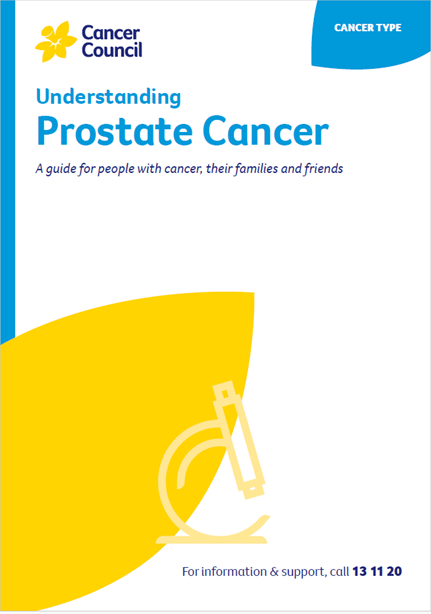- Home
- Prostate cancer
- Diagnosis
- Staging and prognosis
Staging and prognosis for prostate cancer
These tests help your doctors work out if you have prostate cancer and whether it has spread. Working out how far the cancer has spread is called staging. It helps your doctors recommend the best treatment for you.
Learn more about:
Staging prostate cancer
The most common staging system for prostate cancer is the TNM system. In this system, letters and numbers are used to describe the cancer, with higher numbers indicating larger size or spread.
Your doctor may also describe the cancer as:
| localised (early) | the cancer is contained inside the prostate. |
| locally advanced | the cancer is larger and has spread outside the prostate to nearby tissues or nearby organs such as the bladder, rectum or pelvic wall. |
| advanced (metastatic) | the cancer has spread to distant parts of the body such as the lymph nodes or bone. This is called prostate cancer even if the cancer is in a different part of the body. |
TNM staging system
| T stands for tumour | Refers to the size of the tumour (T0–4). T0 is smaller and T4 is larger. |
| N stands for nodes | N0 means the cancer has not spread to lymph nodes; N1 means it has spread to lymph nodes in the pelvis. |
| M stands for metastasis | M0 means the cancer has not spread outside of the pelvis; M1 means it has spread to lymph nodes, bone or other organs outside the pelvis. |
Grading prostate cancer
The biopsy results will show the grade of the cancer. Grading describes how the cancer cells look under a microscope compared to normal cells.
For many years, the Gleason scoring system has been used to grade the tissue taken during a biopsy. If you have prostate cancer, you will have a Gleason score between 6 (slightly abnormal) and 10 (more abnormal).
A newer system has been introduced to simplify the grading and make it easier to understand. Known as the International Society of Urological Pathologists (ISUP) Grade Group system, this grades prostate cancer from 1 (least aggressive) to 5 (most aggressive).
Risk of progression
Localised (early) prostate cancer is given a risk of progression that helps to guide treatment. The risk level is based on the size and grade of the cancer, and your PSA level before the biopsy (see table below):
- low risk – slow growing and not aggressive
- intermediate risk – likely to grow faster and be mildly to moderately aggressive
- high risk – likely to grow quickly and be more aggressive.
Localised (early) prostate cancer risk level
| Risk level | Gleason score | ISUP Grade Group |
| low | 6 or less | 1 |
| intermediate | 7 | 2–3 |
| high | 8–10 | 4–5 |
Your PSA level and the tumour (T) size also help work out the cancer’s risk level.
The stage, grade and risk of progression of prostate cancer is complex, so ask your doctor to explain how it applies to you. Call Cancer Council 13 11 20 for information and support.
Prognosis
Prognosis means the expected outcome of a disease. You can talk about your prognosis and treatment options with your doctor, but they can’t predict the exact course of the disease. They can give you an idea about the general outlook for people with the same type and stage of cancer.
To work out the stage, your doctor will consider your test results, the type of prostate cancer, the stage, grade and risk of progression, how well you respond to treatment, and your age, fitness and medical history.
Prostate cancer often grows slowly — even aggressive cases of prostate cancer tend to grow more slowly than other types of cancer. Some low-risk prostate cancers grow so slowly that they never cause any symptoms or spread; others don’t grow at all.
Compared with other cancers, prostate cancer has one of the highest survival rates if diagnosed early.
→ READ MORE: Your health care team for prostate cancer
Podcast: Tests and Cancer
Listen to more episodes of our podcast for people affected by cancer
Prof Declan Murphy, Consultant Urologist, Director – Genitourinary Oncology, Peter MacCallum Cancer Centre and The University of Melbourne, VIC; Alan Barlee, Consumer; Dr Patrick Bowden, Radiation Oncologist, Epworth Hospital, Richmond, VIC; Bob Carnaby, Consumer; Dr Megan Crumbaker, Medical Oncologist, St Vincent’s Hospital Sydney, NSW; Henry McGregor, Health Physiotherapist, Adelaide Men’s Health Physio, SA; Jessica Medd, Senior Clinical Psychologist, Department of Urology, Concord Repatriation General Hospital and Headway Health, NSW; Dr Gary Morrison, Shine a Light (LGBTQIA+ Cancer Support Group); Caitriona Nienaber, 13 11 20 Consultant, Cancer Council WA; Graham Rees, Consumer; Kerry Santoro, Prostate Cancer Specialist Nurse Consultant, Southern Adelaide Local Health Network, SA; Prof Phillip Stricker, Chairman, Department of Urology, St Vincent’s Private Hospital, NSW; Dr Sylvia van Dyk, Brachytherapy Lead, Peter MacCallum Cancer Centre, VIC.
View the Cancer Council NSW editorial policy.
View all publications or call 13 11 20 for free printed copies.

